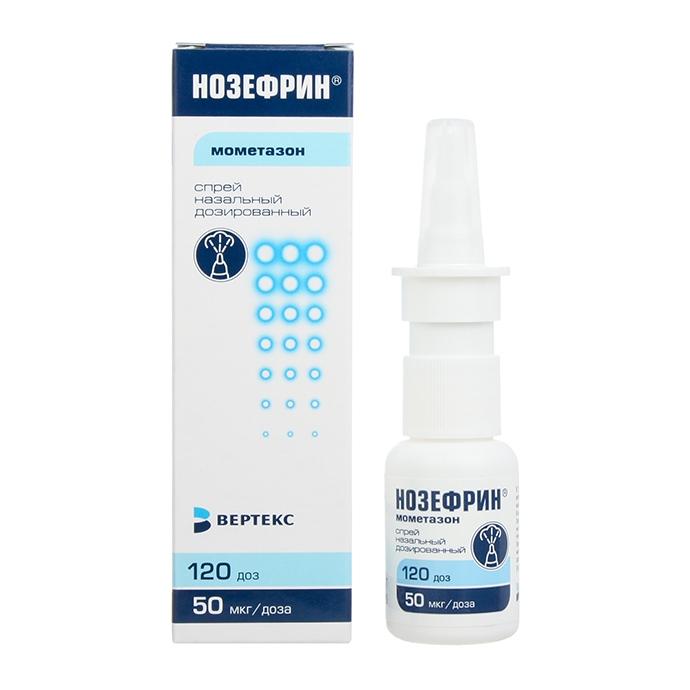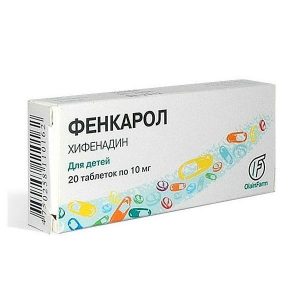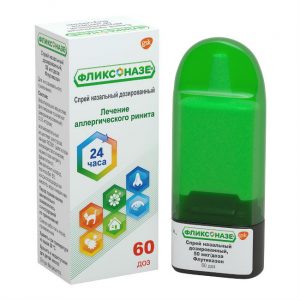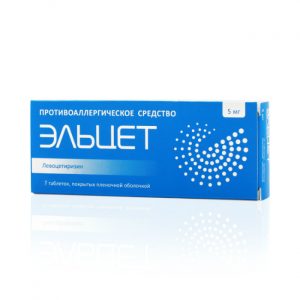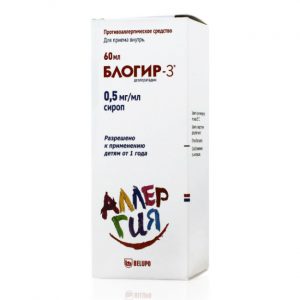Description
Release form
Dosage nasal spray
Indications
seasonal or perennial allergic rhinitis in adults, adolescents, and children from 2 years old
acute sinusitis or exacerbation of chronic sinusitis in adults (including elderly) and adolescents from 12 years of age as part of the complex therapy of
, acute rhinosinusitis with mild to moderate symptoms without signs of severe bacterial infection in patients aged 12 years and older
prophylactic treatment of seasonal allergic rhinitis of moderate and severe course in adults and adolescents from 12 years (recommended 2 4 weeks before the expected start of the dusting season)
nasal polyposis, accompanied by impaired nasal breathing and smell, in adults (from 18 years).
Contraindications
hypersensitivity to mometasone or any of the components,
that is a part of the drug has recently undergone surgery or a nasal injury with damage to the nasal mucosa – before wound healing (due to the inhibitory effect of corticosteroids on the healing process)
childhood (with seasonal and perennial allergic rhinitis – up to 2 years, with acute sinusitis or exacerbation of chronic sinusitis – up to 12 years, with polyposis – up to 18 years) due to the lack of relevant data.
Caution: tuberculosis infection (active or latent) of the respiratory tract, untreated fungal, bacterial, systemic viral infection or Herpes simplex infection, with eye damage (as an exception, it is possible to use the drug with the listed infections as directed by a doctor) untreated local infection involving the systemic effect of corticosteroids in the process of mucous membrane of the nasal cavity pregnancy breastfeeding period.
Use during pregnancy and lactation
Studies of the effect of the drug in pregnant women and breast-feeding women have not been conducted.
As with other nasal corticosteroids, Nosefrin should be used during pregnancy and during breastfeeding only if the expected benefit to the mother outweighs the potential risk to the fetus or newborn.
Newborns whose mothers used the drug Nosefrin during pregnancy should be carefully examined to identify possible adrenal hypofunction.
Special instructions
Do not use in ophthalmology.
When using the drug for a long time (for several months or longer), a periodic examination by a doctor is necessary to timely detect possible changes in the mucous membrane of the nasal cavity.
If a local fungal infection of the nose or pharynx develops, discontinuation of drug therapy and special treatment may be required. Persistent irritation of the mucous membrane of the nasal cavity and pharynx is also an indication for drug withdrawal.
Patients who start treatment with Nosefrin ® nasal spray after prolonged treatment with systemic corticosteroids require special attention. The abolition of systemic corticosteroids in these patients can lead to insufficiency of adrenal function, the restoration of which can take several months. In case of signs of adrenal insufficiency, you should resume taking systemic corticosteroids and take other necessary measures.
During the transition from treatment of systemic corticosteroids to treatment with Nosefrin ® nasal spray, some patients may experience symptoms of systemic corticosteroids withdrawal (including pain in the joints and / or muscles, feeling tired and depressed). Such patients must be convinced of the advisability of continuing treatment with the Nosefrin ® nasal spray. The transition from systemic to local GCS can also reveal previously developed allergic diseases, such as allergic conjunctivitis and eczema, which were previously masked by systemic GCS therapy.
Patients using glucocorticosteroids have a potentially reduced immune response and should be warned about their increased risk of infection in case of contact with patients with some infectious diseases (including chickenpox, measles), as well as the need to consult a doctor if such contact has occurred.
Regular monitoring of the condition of patients receiving the drug for a long time is necessary. With prolonged use of nasal GCS in high doses, the development of systemic side effects is possible. The likelihood of developing these effects is much less than with systemic corticosteroids, and may vary in individual patients, as well as between different corticosteroids. Potential systemic effects include Cushing’s syndrome, characteristic signs of Cushingoid, suppression of adrenal function, stunted growth in children and adolescents, cataracts, glaucoma, and less commonly, a series of psychological or behavioral effects, including psychomotor hyperactivity, sleep disturbance, anxiety, depression, or aggression (especially in children).
It is recommended to regularly monitor the growth of children receiving long-term therapy with mometasone. When growth is slowed down, the therapy should be reviewed in order to reduce the dose of mometasone to the minimum effective dose, which allows controlling the symptoms of the disease. In addition, the patient should be referred for a consultation with a pediatrician.
Treatment of corticosteroids with higher doses than recommended may result in clinically significant inhibition of adrenal function.
When signs of severe bacterial infection appear (including fever, persistent and sharp pain on one side of the face or toothache, swelling in the orbital or periorbital region) immediate medical advice is needed.
When using mometasone in the dosage form, the nasal spray for 12 months showed no signs of atrophy of the nasal mucosa.
The efficacy and safety of mometasone has not been studied in the treatment of unilateral polyps, polyps associated with cystic fibrosis, and polyps that completely cover the nasal cavity. Unilateral polyps of irregular shape or bleeding polyps should be further examined.
Impact on the ability to drive vehicles and mechanisms. Data on the negative effect of the drug in recommended doses on the ability to drive vehicles and mechanisms, as well as perform other activities that require concentration and speed of psychomotor reactions, are absent.
Ingredients
active substance:
mometasone furoate 50 Ñg
excipients:
MCC and sodium carboxymethyl cellulose – 2000 Ñg
glycerol – 2100 Ñg
citric acid monohydrate – 200 Ñg srcd sidlkg 80 Ñg citrate benzalkonium chloride (50% solution) – 40 mcg
purified water – up to 0.1 g
Dosage and administration of
At the first sign of acute respiratory viral infection (within 5 days)
For children from 1 to 3 years old – 2 spray doses in each nasal passage 3-4 times a day (single dose – 20,000 IU, daily dose : – 60000-80000 IU)
Children from 3 to 14 years old – 2 spray doses 4-5 times a day (single dose – 20,000 IU, daily dose – 80,000-100,000 IU)
Adults – 3 spray doses 5 -6 times a day (single dose – 30,000 IU, daily dose – 150,000-180,000 IU).
For the prevention of respiratory viral infections
In contact with the patient and during hypothermia – in accordance with the age-related dosage 2 times a day for 5-7 days. If necessary, repeat the preventive courses. With a single contact, one injection is sufficient.
With a seasonal increase in incidence – in accordance with the age-related dosage once in the morning at intervals of 1-2 days.
Side effects of
Side effects of
In adults and adolescents: headache, nosebleeds (i.e. obvious bleeding, as well as discharge of stained mucus or blood clots), pharyngitis, burning sensation in the nose, irritation of the nasal mucosa, ulceration mucous membrane of the nose, upper respiratory tract infection, sensation of pharyngeal mucosa irritation.
nosebleeds, as a rule, they were moderate and stopped on their own, the frequency of their occurrence was slightly higher than when using a placebo (5%), but equal to or less than when prescribing other nasal GCS, which were used as an active control (in some of them, the frequency of occurrence nosebleeds amounted to 15%). The incidence of all other adverse events was comparable to that of a placebo.
In children: nosebleeds, headache, sensation of irritation in the nose, sneezing. The incidence of these adverse events in children was comparable to that with placebo.
Immediate-type hypersensitivity reactions (including bronchospasm, shortness of breath) have rarely been reported.
Very rarely – anaphylaxis, angioedema, impaired taste and smell.
Also very rare – with intranasal use of GCS, there have been cases of perforation of the nasal septum and increased IOP.
With prolonged use of nasal GCS in high doses, systemic side effects may develop. Potential systemic effects include Cushing’s syndrome, characteristic signs of cushingoid, suppression of adrenal function, stunting in children and adolescents, cataracts, glaucoma, and less commonly, a number of psychological or behavioral effects, including psychomotor hyperactivity, sleep disturbance, anxiety, depression, or aggression (especially in children).
Drug Interactions
With the simultaneous use of mometasone with loratadine, good tolerability was observed by patients.
No effect of mometasone on the concentration of loratadine or its main metabolite in blood plasma was observed.
Interaction studies with other drugs have not been conducted.
Overdose
Symptoms:
inhibition of the function of the hypothalamic-pituitary-adrenal system (may occur in the case of prolonged use of GCS in high doses, as well as with the simultaneous use of several GCS).
Treatment:
due to the low systemic bioavailability of the drug (less than 1% with a sensitivity of 0.25 pg / ml), it is unlikely that any accidental or deliberate overdose will require any measures other than observation with a possible subsequent resumption of the drug at the recommended dose . If necessary, symptomatic treatment.
Storage Conditions
Store in a dark place at 2 to 8 ° C.
Term hodnosty
3 years
lekarstvennaja form
tablets
